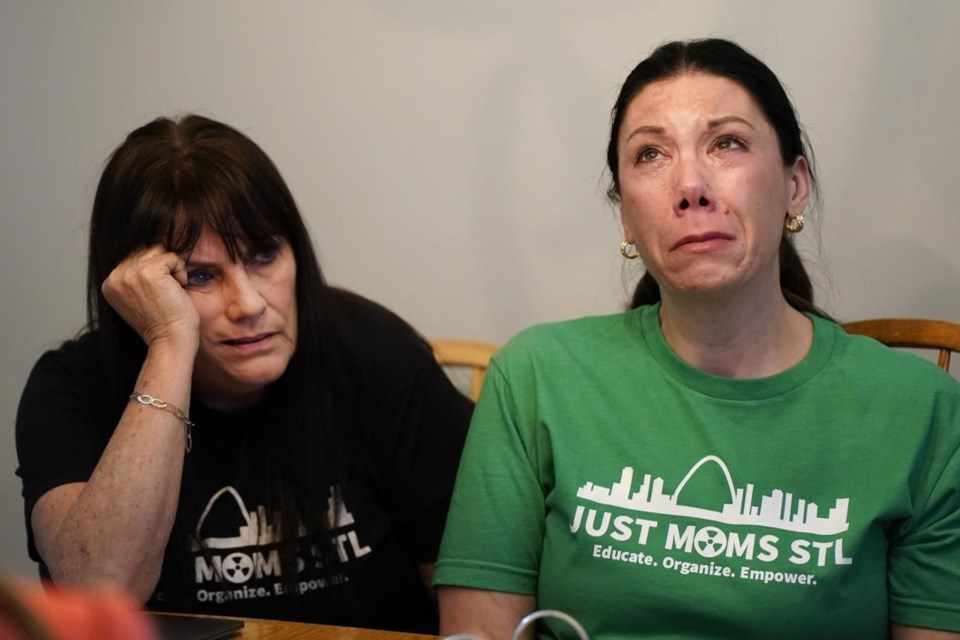ST. LOUIS (AP) — St. Louis-area activists have been fighting for years to get government compensation for people with cancer and other serious illnesses potentially connected to Manhattan Project nuclear contamination. This week marked a major victory, with support coming from the president.
Uranium was processed in St. Louis starting at the onset of World War II as America raced to develop nuclear bombs. In July, reporting as part of an ongoing collaboration between The Missouri Independent, the nonprofit newsroom MuckRock and The Associated Press cited thousands of pages of documents indicating decades of nonchalance and indifference for the risks posed by uranium contamination. The government documents were obtained by outside researchers through the Freedom of Information Act and shared with the news organizations.
Since the news reports, bipartisan support has emerged to compensate those in St. Louis and elsewhere whose illnesses may be tied to nuclear fallout and contamination. On Wednesday, that support extended to President Joe Biden.
“I’m prepared to help in terms of making sure that those folks are taken care of,” Biden said during a visit to New Mexico.
Dawn Chapman and Karen Nickel, who lead the activist group Just Moms STL, said they’re optimistic but not letting up.
“It’s a great day,” Chapman said. “We feel incredible. But we don’t take the time to celebrate it. For us, it’s like we have a strong wind at our back. Now who do we push? We don’t let up for a moment.”
The push for compensation has united politicians with virtually nothing else in common. Republican U.S. Sen. Josh Hawley, of Missouri, is an ardent supporter. So is U.S. Rep. Cori Bush, a St. Louis Democrat.
Hawley introduced legislation last month to expand an existing compensation program for exposure victims. The Senate endorsed the amendment, but the proposed changes to the Radiation Exposure Compensation Act are not yet included in a House-approved defense bill amid negotiations toward final legislation.
St. Louis is far from alone in suffering the effects of the geographically scattered national nuclear program. Advocates have been trying for years to bring awareness to the lingering effects of radiation exposure on the Navajo Nation, where millions of tons of uranium ore were extracted over decades to support U.S. nuclear activities.
Months after the Japanese attacked Pearl Harbor on Dec. 7, 1941, Mallinckrodt Chemical Co. in St. Louis began processing uranium into a concentrated form that could be further refined elsewhere into the material that made it into weapons.
By the late-1940s, the government was trucking nuclear waste from the Mallinckrodt plant to a site near Lambert Airport. It was there that the waste was dumped into Coldwater Creek, contaminating a waterway that was a popular place for kids to play. Just last year, Jana Elementary School, which sits near the creek, was shut down over possible contamination, even though studies conducted by the Army Corps of Engineers found none.
In 1966, the Atomic Energy Commission demolished and buried buildings near the airport and moved the waste to another site, contaminating it, too. Documents cited by AP and the other news organizations showed that storage was haphazard and waste was spilled on roads but that mistakes were often ignored.
Uranium waste also was illegally dumped in West Lake Landfill, near the airport, in 1973. It's still there.
Cleanup in St. Louis County has topped $1 billion, and it's far from over.
Meanwhile, uranium was processed in neighboring St. Charles County starting in the 1950s, creating more contamination. The government built a 75-footmound, covered in rock, to serve as a permanent disposal cell, and the area is considered remediated.
Some experts are skeptical about the connection between diseases and the contamination. Tim Jorgensen, a professor of radiation medicine at Georgetown University, told the AP in July that the biggest risk factor for cancer is age and that local radiation’s contribution would be so low as to be hard to detect.
Still, in 2019, the federal Agency for Toxic Substances and Disease Registry issued a report that found people who regularly played in Coldwater Creek as children from the 1960s to the 1990s may have a slight increased risk of bone cancer, lung cancer and leukemia. The agency determined that those exposed daily to the creek starting in the 2000s, when cleanup began, could have a small increased risk of lung cancer.
Many of those with direct connections to illnesses are far more convinced. Kyle Hedgpeth's young daughter and niece both were diagnosed with cancer in 2020, within a month of each other. Both have since recovered.
Hedgpeth's wife and her brother grew up near a creek that flows from the St. Charles County site. He believes they picked up something from exposure to the creek and passed it down to their girls.
“It seems all too coincidental,” Hedgpeth said. “I just think there's too many red flags literally putting it in their backyard to ignore it.”
Jim Salter, The Associated Press



